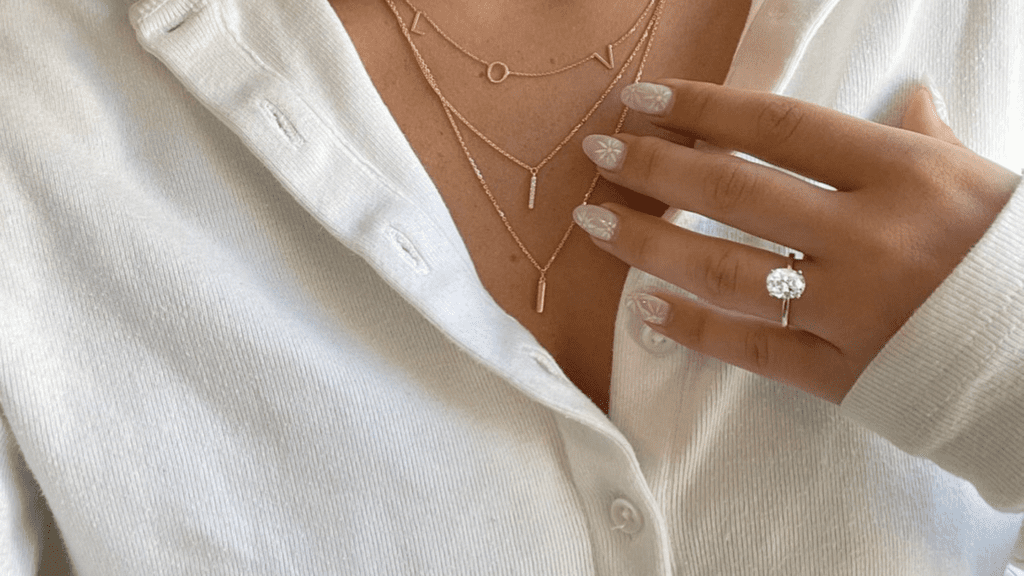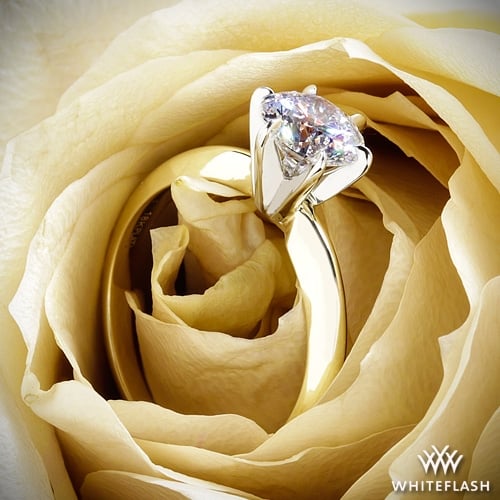In the realm of diamonds, a 2-carat stone is a symbol of luxury and opulence. However, selecting the perfect 2-carat diamond ring is no small feat – it requires a keen understanding of various aspects including costs, cut quality, size, clarity, and color. At PriceScope, we break down these complexities to guide you on this exciting journey. Whether you’re stepping into the world of diamonds for the first time, or are an experienced buyer aiming to add a remarkable piece to your collection, our guide will help you navigate the intricate landscape of 2-carat diamonds.
We’ll explore how cut, color, clarity, and shape can influence the aesthetics and value of your diamond, enabling you to make an informed and confident decision. Join us as we illuminate the path to your ideal 2-carat diamond that matches your personal style, budget, and expectations.
Understanding Costs
Just like their smaller counterparts, not all 2-carat diamonds are created equal. There are multiple variables that significantly influence the price and overall appearance of a 2-carat diamond. Price range for a 2-carat natural diamond can span broadly from approximately $5,000 to $30,000, factoring in different elements like cut quality, clarity, color, and shape. Being knowledgeable about the 4 Cs of diamond quality will greatly enhance your buying experience.
Staying updated with the current market prices is crucial when investing in diamonds. PriceScope's latest diamond prices chart provides real-time data on 2-carat diamonds, helping you make a wise investment decision. Stay informed and get the best value for your money with PriceScope.
Cut Quality for 2-Carat Diamonds
Cut quality remains a prime factor affecting both the price and beauty of a 2-carat diamond. The superior the cut quality, the greater its value and light performance. An ideally or excellently cut diamond is recommended to optimize its sparkle, brilliance, and fire.
2-Carat Diamond Clarity
When it comes to diamond clarity for a 2-carat diamond, it is usually advisable to opt for a minimum clarity grade of VS2. This grade should ensure that inclusions and blemishes are not visible to the naked eye. Nonetheless, it’s always wise to examine the diamond’s clarity yourself or request expert guidance.
2-Carat Diamond Color
Diamond color continues to be a vital factor. For a 2-carat diamond, we recommend selecting a diamond in the H-J range. Diamonds in this range, also referred to as near-colorless, will look as colorless as those in the higher D-F range to the unaided eye but come with a reduced price tag. Cut quality carries more weight than color in determining a diamond’s visual appeal. However, color is still a significant attribute, often down to personal aesthetic preference. Some buyers might favor a warmer hue and choose a lower color grade to attain it.
Ready to embark on your diamond buying journey? Use PriceScope's advanced Diamond Search tool to filter through a vast selection of 2-carat diamonds by cut, color, clarity, and more. Make an informed choice that suits your taste and budget. Start your search today!
2-Carat Diamond Engagement Ring
Comparing 2-Carat Diamond Rings with 1-Carat and 3-Carat Variants
As most diamond enthusiasts know, the carat weight of a diamond is a key determinant of its size and value.
The first thing to understand is that a diamond’s carat weight is not linearly proportional to its size or appearance. A 2-carat diamond won’t appear twice as large as a 1-carat diamond, nor will it look two-thirds the size of a 3-carat diamond. This is because as a diamond’s size increases, its carat weight spreads out over the entire stone, including the depth. So, while a 2-carat diamond will indeed be larger than a 1-carat diamond, the difference might not be as significant as one might initially think.
Price-wise, the cost of diamonds does not increase linearly with carat weight, but rather exponentially. This is primarily due to the rarity of larger diamonds. In the diamond industry, it’s a known fact that larger diamonds are less frequently found than smaller ones. Thus, a 2-carat diamond will not simply be twice the price of a 1-carat diamond – it’s likely to cost more than that. Similarly, a 3-carat diamond will significantly exceed the price of a 2-carat one, again due to the rarity factor.
However, it’s essential to understand that carat weight isn’t the only aspect to consider when purchasing a diamond. The 4Cs—Carat, Cut, Clarity, and Color—all contribute to the overall beauty and value of a diamond. For example, a flawless 1-carat diamond with exceptional cut, clarity, and color can sometimes be more valuable—and visually stunning—than a 2-carat diamond of lower highly-included quality.
Lastly, while discussing the visual appeal and impact, a 2-carat diamond can hit the sweet spot for many buyers. It’s significantly larger than a 1-carat diamond, making it more striking and noticeable, but not as ostentatious or as heavy on the pocket as a 3-carat diamond. This makes 2-carat diamond rings a popular choice for those seeking a balance between size, cost, and practicality, while still making a substantial visual impression.
After exploring our comprehensive guide on 2-carat diamonds, why not use our Jewelry Search function to find the perfect setting? From classic solitaire to modern halo designs, find the ideal home for your chosen diamond. Discover the endless possibilities today.
Choosing the Right Diamond Shape
The shape of a diamond refers to its physical form, and there are many different shapes to choose from. While round cut diamonds are the most popular, many other shapes, known as ‘fancy cuts’, are equally stunning and might better suit your personal style or the style of the wearer.
Round Cut: The round cut diamond is the most popular diamond shape, representing approximately 75% of all diamonds sold. It is also generally the most expensive due to its demand and the fact that more rough diamond is lost in the cutting process. Shop Round Cut Natural Diamonds & Lab Diamonds at Whiteflash
Princess Cut: This is the second most popular shape. The princess cut is traditionally a square shape with sharp, pointed corners. It is less expensive than the round cut because less rough diamond is wasted during the cutting process. Shop Princess Cut Diamonds at PriceScope
Oval Cut: The elongated shape of the oval cut can create the illusion of greater size. The slender shape can also make the finger of the wearer appear longer and slimmer. Shop Oval Cut Diamonds at PriceScope
Pear Cut: Also known as the teardrop shape, the pear cut is both unique and beautiful. It can be worn with the pointed end towards or away from the hand, and the length of the shape can make the fingers appear longer. Shop Pear Cut Diamonds at PriceScope
Cushion Cut: The cushion cut has gained popularity over the past decade. It has a square or rectangular shape with rounded corners, resembling a pillow or ‘cushion,’ hence the name. Shop Cushion Cut Diamonds at PriceScope
Emerald Cut: This shape is more about the clarity of the diamond, as its large, open table (the flat facet on the diamond’s surface) can highlight any inclusions or blemishes. The elongated shape and step cuts of its facets create a sophisticated, glamorous appearance. Shop Emerald Cut Diamonds at PriceScope
Asscher Cut: The Asscher cut is a stepped square cut, often called the “square emerald cut.” It has cropped corners and showcases the clarity of the diamond. Shop Asscher Cut Diamonds at PriceScope
Marquise Cut: This football-shaped cut can maximize carat weight, giving the appearance of a much larger diamond. The long, narrow shape can also make fingers look longer and more slender. Shop Marquise Cut Diamonds at PriceScope
Radiant Cut: The radiant cut combines the emerald cut’s stylish lines with the round cut’s brilliance. It’s a versatile cut that can be used in various ring styles. Shop Radiant Cut Diamonds at PriceScope
Heart Cut: A less common shape, the heart cut diamond is a symbol of love. The complexity of the shape requires a high degree of skill to ensure the proper symmetry and proportion, so it’s essential to find a reputable jeweler. Shop Heart Cut Diamonds at James Allen, and Blue Nile
The shape of the diamond can significantly influence the aesthetic of your ring. Some shapes can make the diamond appear larger, while others highlight the diamond’s clarity. Ultimately, the best shape to choose is the one that most appeals to you or your loved one. Check out the popular diamond shapes on the market in real-time. **Updated monthly at PriceScope

Reasons Why It’s Important To Purchase A Certified 2-Carat Diamond
- Authenticity: Certification from a reputable lab guarantees that the diamond is real and not a synthetic or a look-alike stone such as cubic zirconia or moissanite.
- Quality Verification: A certified diamond comes with a report detailing its specifications, including the 4Cs—Carat, Cut, Color, and Clarity. This document verifies the diamond’s quality and provides transparency about its characteristics, enabling you to understand exactly what you’re buying.
- Value for Money: Certification helps to ensure that you’re paying a fair price for the diamond. By knowing the precise quality and characteristics of the diamond, you can compare prices across different sellers and make a more informed decision.
- Resale Value: If you ever decide to sell or trade-in your diamond in the future, the certification will play a crucial role. Certified diamonds typically have higher resale values because the next buyer or jeweler can be confident about the diamond’s quality.
- Insurance: In case of loss or damage, insurance companies usually require detailed information about the diamond, which is readily available in the certificate. This documentation helps establish the diamond’s value and replace it accurately.
Certification doesn’t just provide assurance—it is a critical tool for comparing diamonds, understanding their worth, and ensuring your investment is sound. It’s important to ensure the diamond is certified by a reputable institution such as the Gemological Institute of America (GIA), the American Gem Society (AGS), or the International Gemological Institute (IGI). These organizations are known for their rigorous standards and unbiased evaluations.
Join the PriceScope online community and connect with other diamond enthusiasts. Share your journey of choosing between a 1-carat, 2-carat, and 3-carat diamond, gain insights from others' experiences, and ask for advice from seasoned buyers and industry experts. Become a part of our vibrant community today.
Final Thoughts
To extract the best value from a 2-carat diamond, prioritize its cut, color, clarity, and shape. We suggest you select a diamond that comes with a credible certificate, ensuring that it maintains its sparkle for generations to come. Purchasing from a trusted vendor, like those found on PriceScope, is an excellent starting point.
Remember, diamond prices are frequently influenced by emotions and can be quite subjective. Identifying a reliable diamond dealer and selecting a diamond with a GIA certificate are crucial steps to validate the diamond’s quality and authenticity.
In conclusion, investing in a 2-carat diamond engagement ring involves careful scrutiny of various factors such as cut, color, clarity, and shape. By adhering to expert advice and conducting exhaustive research, you can secure a high-quality, stunning diamond that offers excellent value for your money.







